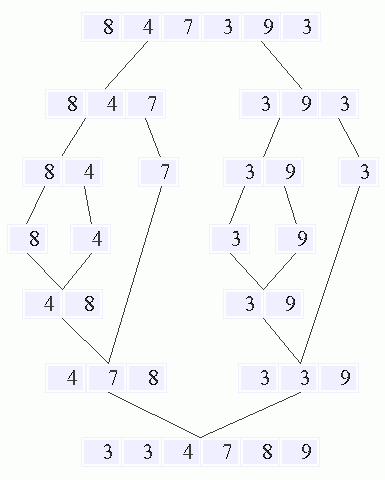The quicksort algorithm is similar to merge sort in that it takes the same divide and conquer approach that the merge sort algorithm uses. Quicksort works by partitioning an array into two sub-arrays. Merge sort does the same thing, but quick sort does it by seperating the partition around a pivot point. The numbers less than the pivot point are placed into the lower array and those above into a higher array. The function then runs recursively continuing to sort the arrays until they are seperated into fully sorted arrays. The array ends completly sorted and merged back into one array. Quick sort is normally extremely fast in practice, although its worst case scenario running time is O(n^2), but the average case is O(n*logn^2) making it the fastest of the five sorting algorithims looked at.
Saturday, April 25, 2009
Quicksort Algorithm
The quicksort algorithm is similar to merge sort in that it takes the same divide and conquer approach that the merge sort algorithm uses. Quicksort works by partitioning an array into two sub-arrays. Merge sort does the same thing, but quick sort does it by seperating the partition around a pivot point. The numbers less than the pivot point are placed into the lower array and those above into a higher array. The function then runs recursively continuing to sort the arrays until they are seperated into fully sorted arrays. The array ends completly sorted and merged back into one array. Quick sort is normally extremely fast in practice, although its worst case scenario running time is O(n^2), but the average case is O(n*logn^2) making it the fastest of the five sorting algorithims looked at.
Friday, April 24, 2009
Merge Sort

Merge Sort is a more advanced sorting algorithm it is more complex to code, understand, and implement, but it also provides a more efficient algorithm. The merge sort algorithm works by dividing the array into separate arrays and then sorting the smaller arrays and then eventually merging the arrays back together sorted. The sorting is done by recursive calls to the merge sort function. The array is divided as many times as it takes in order to get an array with only one element. Once an array with one element is reached the arrays are then placed back together with each array being put back in the proper order through recursive calls to the merge sort function. After each array has been sorted it a call to the function merge places it back into one array properly sequence by keeping track of the smallest element in each array and inserting the smaller of the two until every element has been placed back into the original array. The advantages that merger sort brings is that it has a time complexity of O(nlogn) as compared to O(n^2) of the other three algorithms looked at so far.
Thursday, April 23, 2009
Insertion Sort
Insertion sort is the third sorting algorithm that I will be explaining how it works as well as the advantages and disadvantages of its use. The idea of insertion sort is partitioning the array into a sorted and unsorted sections. Then you insert each element from the unsorted partition into its proper place in the sorted partition. This is easily accomplished by starting the sorter partition with only one element, the first element in the array, the other side will have n-1 elements. The algorithm will continue until eventually the sorted side will have n-1 elements and the unsorted side will have n elements. Then the last element is properly placed into the sorted section and the array has successfully been sorted. The advantages of of insertion sort is that it can be quicker than the other algorithms because it takes into account partially sorted arrays. The only problem is it is still not a very efficient algorithm because when the list is in the reverse order it will end up the same running time as the other two algorithms at big Oh (n^2).
Tuesday, April 21, 2009
Bubble Sort
Pass 1
21 15 43 10 23
15 21 43 10 23
15 21 10 43 23
15 21 10 23 43
Pass 2
15 21 10 23 43
15 10 21 23 43
Pass 3
15 10 21 23 43
10 15 21 23 43
Again the bubble sort algorithm is simple to understand and easy to implement. The disadvantages of bubble sort algorithm is that they can often have long running times due to a large time complexity and the need for many passes of through the entire array.
Saturday, April 18, 2009
Selection Sort
Original Array: 29 10 14 37 13
After 1st swap: 29 10 14 13 37
After 2nd swap: 1310 14 29 37
After 3rd swap: 13 10 14 29 37
After 4th swap: 10 13 14 29 37
The selection sort algorithm is a simple algorithm to implement, but at times can have a relatively large time complexity. It also is an internal sorting algorithm which requires it to all be able to fit in primary memory.
Thursday, April 16, 2009
Sorting Algorithms
Wednesday, April 15, 2009
C++ Standard Template Libraries
Monday, April 13, 2009
Queues
Another ADT is the queue. The queue is the opposite of a stack in that it is known as first in and first out data structure. All data insertions in a queue come in at one end of the list and all the deletions will come at the other end of the list. It can be thought of like the line at the supermarket. A person enters at one end is exits at the other end. There are several ways to implement a queue . The first is a pointer based implementation. The pointer based implementation is essential the same as a linked list with two extra pointers to track the first and last data elements in the queue. The second implementation is done through and array. The array is implemented by setting the max size and when it is completely filled the array dumps the data that was in the last element of the array and shifts all the other elements down to the next element. One of the common uses of queues are when a certain resource is needed by more than one part of the computer. This can commonly be found in the use of a printer since only one item can be printed at a time queues are often used to delegate the sequence of documents printed.
Sunday, April 12, 2009
Stacks
There are several different types of processing data in a computer. One ways is known as a stack. A stack is like a list in that it has a set of functions and set of data. A stack can be thought of as a last in first out data structure. When I was taught about stacks I was told to think of it like a game of cards in which you add a card to the top and the next person can either add a card to the top of the deck or take the card that is on the top of the deck. The same thing happens with stacks of data. When data is placed on the stack it is known as pushing data onto the stack, and when data is removed from the stack it is known as popping the stack. The stack also can inherit all of the same functions of the linked list and then additionally requires a push function, pop function, display and top functions. The display function will be used to display all the elements of the stack. The top function reads the top of the data. One of the limitations of stacks are that you can only access the top element on the stack.

Sunday, April 5, 2009
Linked Lists
Thursday, April 2, 2009
Recursion
Recursion is a function that that either directly or indirectly makes a call to itself. The idea behind recursion is that you can break down a large problem into smaller problems until it is finally just a simple problem to solve. Recursive solutions are somewhat difficult to create because they must be made very carefully. The idea of the solution is for each successive call of the function should bring you closer and closer to an easily solved solution. The easily solved solution is known as the base case. Every recursive case is required to have at least one base case. It also must have at least one general case. The general case is any of the recursive steps that you take in order to get to the base case. A common way to look at a recursive case is by examining a function that computes the Fibonacci number.
int Fibonacci(int n){
if (n == 0)
return 0; // base case
if (n == 1)
return 1; // base case
return Fibonacci(n – 1) + Fibonacci(n– 2); // recursion}
One problem with recursion is that many times you can create an infinite recursion which is similar to an infinite loop. It is a fatal error that will cause the program to never stop running because it cannot get out of infinite recursion. However, recursion can sometimes be the best solution to a problem.
